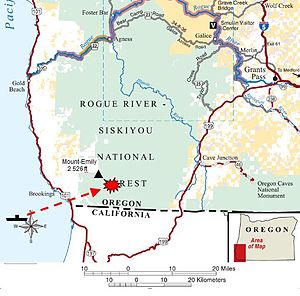Lookout Air Raids
| Lookout Air Raids | |||||||
|---|---|---|---|---|---|---|---|
| Part of theAmerican theaterandPacific theaterofWorld War II | |||||||
 Lookout air raid schema | |||||||
| |||||||
| Belligerents | |||||||
|
|
| ||||||
| Commanders and leaders | |||||||
| Keith V. Johnson |
Tagami Akiji Nobuo Fujita | ||||||
| Strength | |||||||
| 1 patrol offire lookouts |
Sea: 1submarine Air: 1aircraft | ||||||
TheLookout Air Raidswere minor but historicJapaneseair raids that occurred in the mountains ofOregon,several miles outsideBrookingsduringWorld War II.[1]
On September 9, 1942, a JapaneseYokosuka E14YGlenfloatplane,launched from a Japanese submarine, dropped twoincendiary bombswith the intention of starting aforest fire.However, with the efforts of a patrol offire lookouts[2]and weather conditions not amenable to a fire, the damage done by the attack was minor.[3]The attack was the first time thecontiguous United Stateswas bombed by an enemy aircraft.[a]It was also the second time the continentalUnited Stateswas attacked by enemy aircraft during World War II, the first being thebombing of Dutch Harborthree months earlier.
Lookout Air Raids[edit]

On Wednesday morning, September 9, 1942, thesubmarineI-25,under the command ofLieutenant CommanderAkiji Tagami, surfaced west ofCape Blanco.The submarine launched a "Glen"Yokosuka E14Yfloatplane, flown byWarrant OfficerNobuo Fujita[4]andPetty OfficerOkuda Shoji, with a load of twoincendiary bombsof 76 kilograms (168 lb) each.[5]
Howard "Razz" Gardner spotted and reported the incoming "Glen" from his fire lookout tower onMount Emilyin theSiskiyou National Forest.
Although Razz did not see the bombing, he saw the smoke plume and reported the fire to the dispatch office. He was instructed to hike to the fire to see what suppression he could do. Dispatch also sent USFS Fire Lookout Keith V. Johnson from the nearby Bear Wallow Lookout Tower.[citation needed]Fujita dropped two bombs, one on Wheeler Ridge on Mount Emily inOregon.The location of the other bomb is unknown. The Wheeler Ridge bomb started a small fire 16 km (9.9 mi) due east ofBrookings.[6]
The two men proceeded to the location and were able to keep the fire under control. Only a few small scattered fires were started because the bombs were not dropped from the correct height.[citation needed]The men stayed on scene and worked through the night keeping the fires contained. In the morning, afire crewarrived to help. A recent rain storm had kept the area wet, which helped the fire lookouts contain the blaze.[citation needed]
Aftermath[edit]

A full investigation was launched by theFederal Bureau of Investigation,which resulted in locating several bomb fragments. The story was reported in several newspapers on September 10, 1942.[citation needed]Lieut. Gen.John L. DeWitt,the area commander announced,
TheWestern Defense Commandis investigating the circumstances surrounding the discovery on Sept. 9 of fragments of what appears to have been an incendiary bomb. These fragments were found by personnel of the United States Forestry Service near Mt. Emily nine miles northeast of Brookings, Or. Markings of the bomb fragments indicated that the missile was of Japanese origin.[2]
The floatplane carried two bombs. Both were dropped, according to the Japanese records, but no trace has yet been found of the second bomb.[citation needed]One of the bombs left a foot-deep crater.[2]Fujita and his observer made a second attack on September 29, again causing only negligible damage.[citation needed]
Postwar[edit]
Twenty years later, Fujita was invited back to Brookings. Before he made the trip theJapanese governmentwas assured he would not be tried as awar criminal.In Brookings, Fujita served as Grand Marshal for the local Azalea Festival.[1]At the festival, Fujita presented his family's 400-year-oldsamurai swordto the city as a symbol of reconciliation. Fujita made a number of additional visits to Brookings, serving as an "informal ambassador of peace and friendship".[7]Impressed by his welcome in the United States, in 1985 Fujita invited three students from Brookings to Japan. During the visit of theBrookings-Harbor High Schoolstudents to Japan, Fujita received a dedicatory letter from an aide ofPresident Ronald Reagan"with admiration for your kindness and generosity". Fujita returned to Brookings in 1990, 1992, and 1995. In 1992 he planted a tree at the bomb site as a gesture of peace. In 1995, he moved the samurai sword from the Brookings City Hall into the new library's display case. He was made an honorary citizen of Brookings several days before his death on September 30, 1997, at the age of 85.[8]In October 1998, his daughter, Yoriko Asakura, buried some of Fujita's ashes at the bomb site.
See also[edit]
Notes[edit]
- ^As well as only the second time in history that the contiguous U.S. was bombed by someone working for a foreign power, the first being thebombing of Naco, ArizonabyPatrick Murphy,although the Murphy bombing inside the U.S. was an accident.
References[edit]
- ^abBingham, Larry (2008-10-02)."Oregon coast trail dedicated for World War II bombing".The Oregonian.Retrieved2009-02-04.
- ^abcJap Incendiary Sets Forest Fire. DeWitt's Announcement Hints Raider May Have Been Launched From Submarine Off Coast, Later Attacked by Patrol Planes
- ^The Journal of military history, Volume 53, p. 172. Virginia Military Institute, American Military Institute, George C. Marshall Foundation, 1989
- ^CBS News. Steve Hartman.A Soldier's Story: Steve Hartman Talks To An Oregon Veteran
- ^Mochitsura Hashimoto (1954).Sunk.
- ^McArthur, Lewis A.;McArthur, Lewis L.(1992) [1928].Oregon Geographic Names(6th ed.). Portland, Oregon:Oregon Historical SocietyPress. p. 898.ISBN978-0875952369.
- ^Burel, Patty (2008-09-19)."Trail Dedication at Japanese Bombing Site Set".FS Today.Archived fromthe originalon 2015-10-03.Retrieved2011-09-07.
- ^Kristof, Nicholas (1997-10-03)."Nobuo Fujita, 85, Is Dead; Only Foe to Bomb America".New York Times.Retrieved2009-03-04.
External links[edit]
- 1942 in Oregon
- Aerial operations and battles of World War II
- Airstrikes conducted by Japan
- American Theater of World War II
- Battles and conflicts without fatalities
- Conflicts in 1942
- Curry County, Oregon
- History of Oregon
- Rogue River-Siskiyou National Forest
- September 1942 events
- Japan–United States military relations

